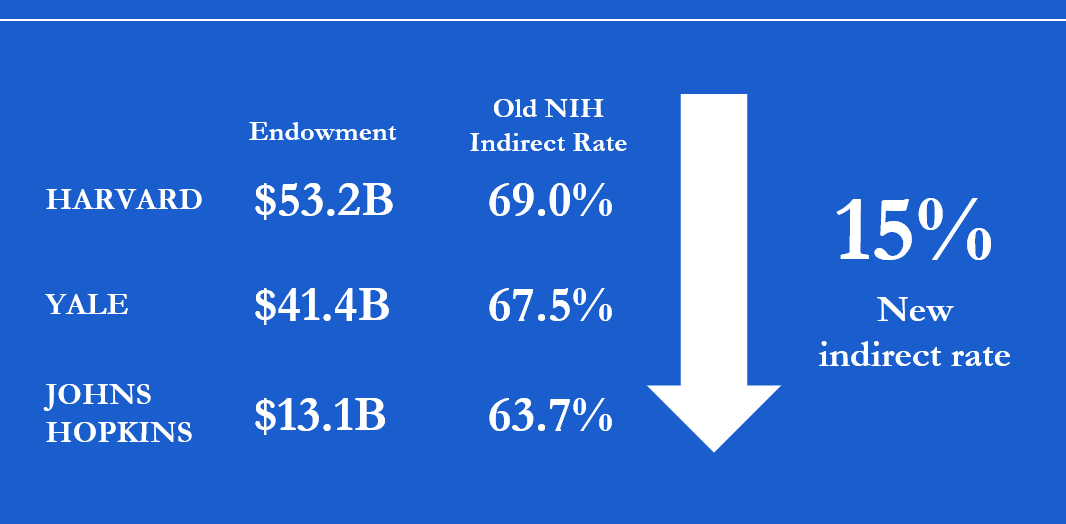
Chris Clarke
@tallcat78
Followers
133
Following
13K
Statuses
3K
Tall, British-American, Scientist. Unashamed geek. Studying sphingolipids in cancer and making sudoku puzzles on the side. Thoughts, opinions are my own.
Stony Brook, NY
Joined November 2012
RT @doristsao: I, and every scientist I've talked to, believe the end result of this devastating cut will be that Universities will simply…
0
175
0
@cmonjussthetip @dietbrisk @whstancil The standard NIH research grant has a maximum request of $250K per year direct costs. There is an alternative that has a cap of $500K per year. For big ticket equipment, that would take an entire year or more of budget.
1
0
16
Precisely this.
The indiscriminate and ill-conceived slashing of indirects by the @NIH yesterday must be amended if want to restore America’s leadership role biomedical research. 15% simply isn’t enough for institutions to provide the basic infrastructure needed to run a successful lab. I say this as someone who has been and remains deeply critical of the NIH, its funding system and of the ways universities are structured and spend money. We would all benefit from a genuine reexamination of how and to what @NIH funds are allocated, and I remain optimistic that once the dust settles and new NIH leadership is in place that this is what will happen and this hack job by people who don’t understand or care about research will be forgotten. And I’m sorry but I can’t help but laugh at the people who are demanding a full-throated defense of the current indirect levels. Nearly every PI I’ve known for my entire career has complained about excessive indirect rates. This is mostly because, despite their importance, even most PIs haven’t bothered to actually understand them, and because they don’t FEEL that universities are actually spending the money to support their research. Whether they are or not nobody really knows because in the typically Byzantine maze of university budgets it’s often very hard to figure out. There are also lots of actual shenanigans that go on especially at places with the highest indirect rates to use funds to build out the institution and increase its power rather than to directly support funded research projects. And anyone who says administrative bloat at universities isn’t real and partially fueled by indirects is either blind or part of the bloat. So let’s get organized to have an actual constructive response to this firebomb. Scientists need to advocate for what is best for research - and we have to do it ourselves because the institutions that claim to represent us - universities and scientific societies in particular - have their own goals that often do not align with ours. We also have to remember that grants are not an entitlement. We are not owed anything. If we want to continue benefiting from the public support we have always enjoyed, we have to show the public and their representatives - even ones we might not always agree with - that we’re spending their money wisely.
0
0
0
@cmonjussthetip @dietbrisk @whstancil Sure, I’ll blow two years of my grant budget on a mass spec. That’ll look good in my progress report “I didn’t do anything cause I spent it all on a mass spec”
1
0
27
@cmonjussthetip @dietbrisk @whstancil Yeah, I need a mass spec for my work which costs about $500K. Pretty sure I won’t be able to buy that on a direct cost modular grant at $250K a year.
2
0
16
@The_Gilp Yet it's still absolutely essential that they throw another few hundred billion at the DOD for....reasons.
0
0
0
Of course, all the money you are saving in indirect costs is going to be re-invested as direct costs for research grants, right? Right?
Last year, $9B of the $35B that the National Institutes of Health (NIH) granted for research was used for administrative overhead, what is known as “indirect costs.” Today, NIH lowered the maximum indirect cost rate research institutions can charge the government to 15%, above what many major foundations allow and much lower than the 60%+ that some institutions charge the government today. This change will save more than $4B a year effective immediately.
0
0
0
Highly encourage attending this conference. Should be a good one (and the registration is very competitive!)
The early bird deadline may have passed but there is still plenty of time to register and submit abstracts for the 2025 FEBS/ICC! Come to historic Varna for sun, sea, and sphingolipid science!!
0
0
0
@SiskindLeah @BernieSanders Unfortunately the party in control of congress agrees with the lawsuits
0
0
0
RT @SL_Biology: @CaymanChemical have been stalwart supporters of the lipid community over the years and we are excited and grateful they ar…
0
1
0
RT @SL_Biology: 🚨🚨🚨 Only two days left to take advantage of lower registration for FEBS 2025 Sphingolipid Biology meeting! The final deadli…
0
3
0
RT @SL_Biology: 🚨🚨🚨 Important! At the request of attendees, we have extended the early bird deadline by one more week to Friday Jan 24th. T…
0
2
0
RT @SL_Biology: 🚨🚨🚨Attention all graduate students!! The deadline to apply for FEBS Travel Funds for the 2025 FEBS Special Meeting/13th ICC…
0
2
0





